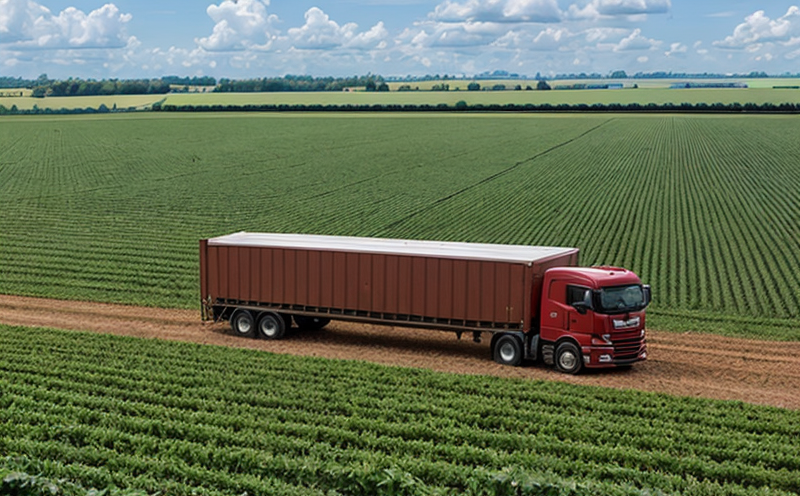Transit Stability Testing for Stacked Goods
The need to ensure that agricultural goods are safely transported and delivered in optimal condition is paramount. Transit stability testing for stacked goods aims to assess how different types of packaging and stacking configurations affect the structural integrity, stability, and overall quality of the cargo during transit. This service is critical for ensuring compliance with international standards and meeting customer expectations.
Transit stability tests are often conducted in specialized laboratories equipped with simulators that mimic real-world conditions such as vibration, temperature fluctuations, humidity, and shock. These tests are essential to understand how the goods will behave under various stressors encountered during transport. By understanding these behaviors, stakeholders can optimize packaging designs, improve stacking methods, and enhance overall supply chain efficiency.
The testing process involves carefully selecting specimens that represent typical load configurations found in real-world scenarios. Specimens may include different types of agricultural products packed in various containers, such as crates, pallets, or polyethylene bags. The testing parameters are designed to simulate the expected transit conditions, including speed, acceleration, and environmental factors like temperature changes and exposure to rain.
Once specimens are prepared, they undergo rigorous testing using sophisticated instrumentation capable of measuring forces, accelerations, displacements, and stresses experienced during transport. Data collected from these tests provide insights into potential weaknesses in packaging design or stacking methods that could lead to damage or loss of product quality. This information is invaluable for improving future designs and ensuring consistent high-quality performance across all shipments.
Testing laboratories typically report findings based on industry standards such as ISO, ASTM, EN, IEC, etc., which provide benchmarks against which results can be compared. Compliance with these standards ensures that tests are conducted uniformly and consistently worldwide, fostering trust among buyers and sellers alike.
In summary, transit stability testing for stacked goods plays a vital role in safeguarding agricultural products during transportation by identifying potential risks early on so they can be addressed before actual shipments occur.
Applied Standards
- ISO 14037:2016 - Packaging and packaging waste - Information to be provided by the producer: This international standard specifies requirements for providing information about the environmental impacts of packaging, including its components.
- ASTM D5893-18 - Standard Test Method for Determining Shock Response Spectra of Packaging Systems: This method describes how to measure shock response spectra (SRS) from impact tests on packaged materials using accelerometers.
- EN 12746:2010 - Packaging and packaging waste - Guidelines for the design, manufacture, use, recycling and recovery of packages made from biodegradable plastic materials: This European standard offers guidance on designing packages that are both environmentally friendly and effective in protecting products during transit.
- IEC 62368-1:2014 - Safety of information technology equipment - Part 1: General requirements for the safety of information technology equipment: Although primarily aimed at IT equipment, this standard can also apply to certain types of packaging used in electronic devices.
These standards ensure that transit stability testing adheres to best practices and meets regulatory requirements, thereby enhancing reliability and consistency in test outcomes.
Why Choose This Test
- Ensures Product Integrity: By simulating various transport conditions, this test helps maintain the quality of agricultural goods throughout transit.
- Promotes Compliance: Following recognized standards ensures that your testing aligns with global regulations and industry best practices.
- Improves Design: Insights gained from these tests can be used to refine packaging designs, enhancing both protection levels and cost-effectiveness.
- Reduces Risk: Identifying potential issues early allows for proactive measures that minimize risks associated with damaged goods or non-compliance penalties.
Choosing transit stability testing not only enhances product integrity but also supports sustainable practices aligned with international standards. This approach fosters trust among stakeholders and contributes to a more efficient supply chain.
Quality and Reliability Assurance
- Data Accuracy: Rigorous adherence to testing protocols ensures accurate measurement of forces, accelerations, displacements, and stresses experienced during transport.
- Consistent Results: By following established standards, the same tests can be reliably conducted across different locations and times.
- Comprehensive Reporting: Extensive documentation provides detailed information on test conditions, results, and recommendations for improvement.
The combination of precise instrumentation, adherence to international standards, and comprehensive reporting makes transit stability testing a cornerstone of quality assurance efforts. This service helps ensure that agricultural goods arrive at their destinations in optimal condition, thereby supporting sustainable practices and fostering trust among stakeholders.





